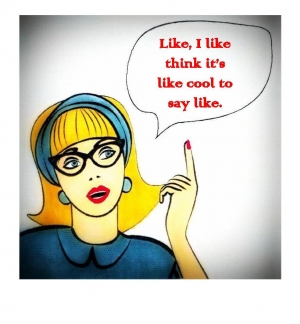The “like” virus going around may not have infected you yet. If you are over 50 you’re probably immune. How can you tell if you’ve got it? Simply count the number of times you use the word like in a sentence. Here are some examples:
The school is like only five blocks from my house.
They like love you!
I have like no clue.
What’ll be like your major?
What’s like wrong with your sister?
Just be like quiet.
I like don’t care.
I didn’t go anywhere like.
Sound familiar? Peppering one’s speech with like has become epidemic in America. It’s been growing since the 1950s. Linguists think that a television character named Maynard G. Krebs on the Dobie Gillis series (1959-1963) popularized the use of like. The Krebs character did not invent the like virus, but he exposed millions of viewers to it. The use of like died down for a few decades, then caught fire again in the 1980s when the stereotype Valley Girl was celebrated in pop culture. The spread of like was also fueled by the TV character Shaggy on the cartoon series Scooby Doo. Shaggy’s personality and speech were inspired by the Maynard G. Krebs character. The like virus has proven to be enduring and powerful because it is versatile.
- Like can function as a filler similar to “you know,” uh, er, and um. Examples:
My math teacher, like, told me, like, the pop quiz wouldn’t, like, hurt my 6-week’s grade, because he used this, like, formula to, like, curve my average.
- Like can function as a filler similar to “you know,” uh, er, and um. Examples:
My math teacher, like, told me, like, the pop quiz wouldn’t, like, hurt my 6-week’s grade, because he used this, like, formula to, like, curve my average.
- Like can also be used to replace standard words such as “say” or “think.” Examples:
She was like, “Don’t wait for me.” He was like, “Okay, I guess so.” They were like, “You’re acting immature.”
- Like can be used to approximate a quantity or shade of meaning. Examples:
There were like 100 people in the store. Like 3,000 live here.
- Like can be used to introduce gestures and unspoken ideas and sentiments. Examples:
He was like (speaker shrugs shoulders). We were all like (speaker rolls eyes). I like (speaker nods head “yes”), and she was like (speaker moves head from side to side “no”), so now we’re (speaker waves hand in dismissal).
- Like can be used as punctuation to signal the end of a sentence. Examples:
We don’t want to go to grandma’s, like. Batman is not my favorite super hero, like.
The strange thing about the like virus is that it is strictly verbal. It doesn’t show up in formal writing. Teenagers use some forms of the like pattern in texting, but when word count is at stake, they omit the like, opting for wow instead of Like wow.
There’s no linguistic vaccine or cure for the like virus, but some activities succeed in stamping it out. Learning to speak, read, and write in a foreign language drastically improves one’s ability to be precise and articulate in speech and writing. The practice of writing also improves thinking, logic and speech.
If you are like virus-free, you can be proud that you did not pick up a speech pattern that makes one sound less than articulate and intelligent. If you used to have the like virus and now you don’t, be reassured that as we get older we sound smarter!



New Comment